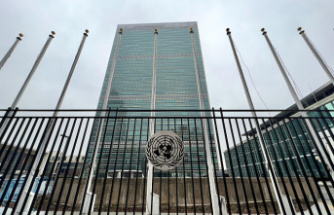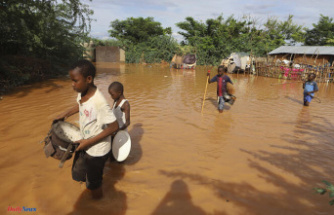The heating may not be on yet, because who wants to pay gigantic energy bills? Then the money for books will be tight and that would be a shame. So we make ourselves comfortable with hot tea and a wool blanket and read, for example a graphic novel or an escape story.
A cult DJ as a comic hero
"The Life of Vernon Subutex", the book trilogy by Virginie Despentes about a Parisian record shop owner who is pushed out of society by digitization and who ends up on the streets until he is resurrected as a DJ guru, has achieved cult status in recent years. The novels not only spawned countless Spotify lists (of all things!), but also several plays and a TV series across Europe. So now also a graphic novel. Drawn by none other than Luz.
Renald Luzier, known as Luz, is the cartoonist who, by accident, escaped the terrible attack on the editorial office of the magazine "Charlie Hebdo" on January 7, 2015. The same day saw the publication of the first volume of Vernon Subutex and Michel Houellebecq's Submission, two books that described and prophesied the disintegration of French society. Since then, Luz has been living in secret places under police protection. Despentes thought he was the only one who could translate her Vernon into a graphic novel, and she's right. In sometimes gloomy, sometimes brightly colored pictures, with allusions to famous record covers and the flashiest orgasm scene imaginable on black cardboard, Vernon Subutex once again becomes a cult figure. For Luz, work becomes a rebirth: "Thanks to Vernon, I was back in Paris, I knew all the characters from the novel as if they were friends from before, I could listen to music again." (sla)
If the forest doesn't stop burning
It's hot, an endless summer without rain. The forest is on fire and an app reveals whether you can only dare to go outside with a mask because of the smoke. A health resort has become a forest fire area, with over 30 degrees every day, even in October. Here Iris stays in the now always empty hotel that she once inherited from her grandfather. One day a woman with a little girl is at the door and Iris takes them in despite the ban on accommodation. But what brought the two to this place? Is the mother even able to take care of her child? Is she as attracted to Iris as she is to her? Should Iris tell the stranger's husband on the phone that the wife and child actually stayed at the hotel? Or did the two escape? "Summer forever" is depressing to read on hot days when the police accidentally set fire to Grunewald next door. But you can't put the book down either - Franziska Gänsler draws the reader into her compact debut novel right from the start. Perhaps the story was once planned as a dystopia. With the forest fires, warning apps, disillusioned climate protectionists camping in the forest and everyday life that you have to cope with under difficult conditions, "Ewig Sommer" is the book about the situation. The small private shrinks in the heat of climate change, the climate crisis loses importance in the face of private dramas. Every day anew. (sla)
Write like Tolstoy. At least.
Danger! This book is for nerds. book nerds. And those who dream of classrooms in old brick walls, where the leaves are changing color outside and the old radiator is knocking inside while you wonder whether Chekhov or Turgenev constructed their stories better. Or is it Tolstoy? George Saunders, the short story king and Man Booker prizewinner, has written a book for those who haven't yet taken his creative writing classes at Syracuse University. For "Swimming in a Pond When It Rains," Saunders took on four Russian literary grandmasters, explained why their short stories work so well, and then gave them homework.
So although it's a proper workbook, Saunders becomes a favorite teacher after just a few pages - especially when he shares his own failures in a witty and refreshing way. But he also shares some uncomfortable truths for aspiring writers:
1. The writer we wanted to be isn't always the writer we are. That's why we're unique (Saunders himself wanted to be Hemingway and only became... Saunders).
2. Authors who end up publishing are the ones willing to revise their writing over and over again.
3. Successful women writers are the ones who sit at their desks for many, many, many hours (see 2).
You can spend a few hours reading this book. And last but not least, learn how elegant gendering feels when you simply take advantage of many opportunities to use the feminine form without making a big story out of it. (sla)
On the trail of an escape
When you hear the word flight, you think of Ukrainian women and children or people trying to reach Europe in boats. But many families in Germany have experienced flight in their own history, including that of Christiane Hoffmann, the deputy spokeswoman for the federal government. The maternal family comes from East Prussia, that of the father from Silesia.
For "Everything we don't remember", Hoffmann set out alone and on foot, which her then nine-year-old father Walter made from Rózyna in Poland to Germany. It runs 558 kilometers exactly 75 years later. She remembers the nightmares in her childhood, in which her parents' escape stories became a threat to her own life, and she is in constant dialogue with her father, who himself only spoke taciturnly and always the same sentences about the escape. He was on the road with his mother and other Rosenthalers for 40 days. Hoffmann needs three maps to reconstruct the route.
Hoffmann tells the people she meets that she is following her father's path. Above all, however, she goes her own way, which brings her closer to the answer to the question of why she feels an inexplicable inner terror in the idyll of the family home in Wedel near Hamburg. Hoffmann has previously learned Polish and in the places his father left behind he meets other refugees who are trying to settle down here. "You know longing, silence and anger," writes Hoffmann about her family. "What you don't know is grief." But these traumas continue to have an effect in her life and at the same time they happen to other people. One cannot read Hoffmann's book with its sensitive descriptions and self-explorations without being aware of it. (sba)
Poke for better understanding
From time to time, the Italian science journalist Francesca Buoninconti tackles a topic that then takes on astonishing proportions. In "Tierisch Laut" it is the communication of animals. She became curious while "birdwatching", ie observing birds. She not only noticed chirping, warbling or cooing, but also that great crested grebes dance and exchange algae and aquatic plants.
Just as people don't just talk to each other, animals also have very different communication strategies that take place, for example, on a visual, auditory, tactile or olfactory level. The waggle dance of the bees may still be familiar to some. But that cicadas nudge each other in addition to the intense chirping? And how do whales actually sing if they don't have any vocal cords? Or how do crocodiles do?
Sometimes you just don't know, like with the crocodiles. Very often, however, Buoninconti comes up with highly interesting and insightful explanations that are also extremely exciting for non-biologists. It becomes clear that communication in the animal kingdom is more complex than people want to admit. Of course, lies and dissimulations also occur. And often enough people disturb what animals are trying to communicate with their noises. (sba)
(This article was first published on Sunday, October 09, 2022.)












